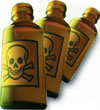

The volume of goods transported by road is ever increasing resulting in a significant increase in the variety of hazardous materials conveyed over the roads of South Africa. This, coupled with the ever-increasing volume of traffic on the roads, has led to an increase in the risk of accident or other incidents involving such vehicles. Should an incident result in fire or in leakage of the product, there is a possibility of hazard to the public and the public emergency services (traffic department, fire brigade, police, etc) are likely to be called out to the incident. In order that emergency personnel can effectively and safely perform their functions at the scene of the incident, it is essential that they have the following information immediately available.
a) Knowledge of what material is involved.
b) Knowledge of the principal hazards presented by the material.
c) Knowledge of what to do (and what not to do) to safely contain the hazard immediately on arrival.
d) Knowledge of where to obtain further specialist advice and help once the initial phase of containment of the incident is complete.
The 'Hazchem' system of placarding tankers conveying hazardous materials was originally devised in the UK to meet these needs and has been modified to meet South African conditions. The system became compulsory in July 1987.
The 'Hazchem' system comprises two parts:
* 'Hazchem' placards for tankers.
* 'Hazchem' cards for the interpretation of the emergency notes on the labels.
The 'Hazchem' placard
Each placard is divided into five parts as follows:
i) The Hazchem Diamond
The purpose of this part of the label is to advise the public and emergency services of the nature of the primary hazard of the material being transported, eg: corrosive. The diamonds are used internationally for materials in transit, and use standard combinations of words, colour and pictograms to set out such hazards as corrosive (black and white). flammable (red), toxic (white), oxidising agent (yellow), compressed gas (green), etc.
ii) UN Number
The purpose of this part of the placard is to provide a material identification so that, if emergency personnel have to request help from the manufacturer or supplier, they can accurately transmit details of the load. As many hazardous materials have complicated names which do not transmit well over telephone or radio voice links, the substance is identified on the 'Hazchem' placard by its United Nations number, eg, 1830, an internationally accepted four digit identification peculiar to that material. It has been shown in tests that numbers transmit more accurately over telephone links than do chemical names.
To assist drivers, loaders and others who have to fill, unload, or label the tankers, the name of the material is also displayed in small print below the UN Identification Number.
Reference lists of UN Numbers with corresponding chemical names are kept by manufacturers and elsewhere, to provide easy translation of number to material name and vice versa.
iii) The 'Hazchem' code
The purpose of the 'Hazchem' code is to provide emergency services with sufficient immediate information to enable them safely to contain the effects of the incident as soon as they arrive on the scene. The code is in the form of two or three numbers/letters which are interpreted by a pocket card carried by all emergency personnel, eg, 2P.
The size, layout and colour of the placard remains the same. Differences occur with the hazard diamond and other information.
When multiloads are transported the hazard diamond will display a large exclamation mark if different hazards are represented. Loads of common primary hazard will be indicated as such, eg: flammable, corrosive. The UN number will disappear in the case of multiloads and will be replaced by the word 'Multiload'.
The Hazchem code will be appropriate for any combination of products on the vehicle as these products must be compatible with one another.
Compartment placard
An additional placard will be displayed on each compartment of a multicompartment vehicle indicating only the substance identification number (eg, 1930 for sulphuric acid) and the appropriate hazard diamond (eg, corrosive).
Reference: Fire Protection Association of Southern Africa.

© Technews Publishing (Pty) Ltd. | All Rights Reserved.